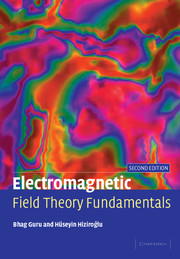Book contents
- Frontmatter
- Contents
- Preface
- Acknowledgments
- 1 Electromagnetic field theory
- 2 Vector analysis
- 3 Electrostatics
- 4 Steady electric currents
- 5 Magnetostatics
- 6 Applications of static fields
- 7 Time-varying electromagnetic fields
- 8 Plane wave propagation
- 9 Transmission lines
- 10 Waveguides and cavity resonators
- 11 Antennas
- 12 Computer-aided analysis of electromagnetic fields
- Appendix A Smith chart and its applications
- Appendix B Computer programs for various problems
- Appendix C Useful mathematical tables
- Index
6 - Applications of static fields
Published online by Cambridge University Press: 05 June 2012
- Frontmatter
- Contents
- Preface
- Acknowledgments
- 1 Electromagnetic field theory
- 2 Vector analysis
- 3 Electrostatics
- 4 Steady electric currents
- 5 Magnetostatics
- 6 Applications of static fields
- 7 Time-varying electromagnetic fields
- 8 Plane wave propagation
- 9 Transmission lines
- 10 Waveguides and cavity resonators
- 11 Antennas
- 12 Computer-aided analysis of electromagnetic fields
- Appendix A Smith chart and its applications
- Appendix B Computer programs for various problems
- Appendix C Useful mathematical tables
- Index
Summary
Introduction
Now that we have discussed the fundamentals of electrostatic and magnetostatic fields, we can explain some of the applications of static fields. It may appear unusual that we have devoted a complete chapter to discussing the applications of static fields when some of these applications could easily have been included in the preceding chapters. We have several reasons for doing so:
To discuss some of the applications in their entirety requires knowledge of both electrostatic and magnetostatic fields. For instance, the acceleration of a charged particle in a cyclotron is accomplished by an electric field, whereas the rotation is imparted by a magnetic field.
By presenting the major applications of static fields in one chapter we hope to convince the reader of their importance. We have seen some recently published textbooks that tend to skip over the subject of static fields as if they are of no significance.
If there is not enough time to discuss the applications of static fields in the classroom, we presume that this chapter epitomizes a very good reading assignment for the student.
Deflection of a charged particle
One of the most common applications of electrostatic fields is the deflection of a charged particle such as an electron or a proton in order to control its trajectory. Devices such as the cathode]-ray oscilloscope, cyclotron, ink-jet printer, and velocity selector are based on this principle.
- Type
- Chapter
- Information
- Electromagnetic Field Theory Fundamentals , pp. 241 - 275Publisher: Cambridge University PressPrint publication year: 2004



